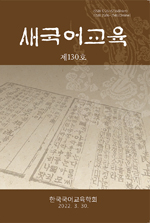이 연구는 수업 중 학습 목적 메모하기 행위를 듣기와 쓰기의 통합 활동의 차원에서 살펴보는 것을 목적으로 한다. 특히 메모하기 지도에서는 이해의 속성에만 집중하기보다는 적극적인 의미 구성의 차원을 강조할 때 그 효과가 더욱 커질 수 있다는 점에서 그 의의를 찾을 수 있다. 이에 본 연구에서는 31명의 고등학교 학습자들의 메모하며 듣기 양상을 질적으로 분석하여 효율적 메모군, 기술적 메모군, 명시적 메모군의 유형으로 구분하였으며 각 유형별로 듣기-쓰기 관계의 어떠한 지점이 문제가 되었는지 알아보았다. 효율적 메모군은 구조화, 재진술 등을 통해 가장 효율적인 메모 방식을 보여주었던 데 반해, 기술적 메모군은 메모 분량은 많아도 산만하고 두서없으며 자신의 언어로 소화해내지 못했다는 점에서 적절한 학습 효과를 보장할 수 없었다. 명시적 메모군은 판서 이외의 메모 자체가 별로 없었으며 이해를 돕기 위한 것이라기보다는 직접적인 요구에 의한 작성에 가까웠다. 그러므로 학습 목적 메모하기 지도의 방향은 ‘듣기 위한 쓰기’의 개념으로 접근해야 함을 제안하면서, 이에 따른 기술적 메모군과 효율적 메모군의 지도 전략들을 제시하였다.
This study aims to define note-taking as an integrated activity of listening and writing and to look for a possibility of its instruction. Note-taking has been dealt with as a listening activity in the Korean national curriculum; however, it has both orality and literacy in itself and need to be regarded as an integrated language activity, especially, between listening and writing. Thus, this study was designed by qualitative research methods and has analyzed notes of 31 high school students during taking a lecture. The result was presented in terms of three note-taking types:efficient memo group, descriptive memo group, and explicit memo group. Efficient memo group showed the most efficient note-taking by using structuralization and paraphrases, whereas descriptive memo group showed a drop in efficiency by distracted and incoherent note-taking with little change from orality. Explicit memo group just showed note-taking close to direct demands. Thus, both descriptive and explicit memo group have shown problems in the transition between orality and literacy, and in the construction of one’s own meaning. As for descriptive memo group, educational treatments can be implemented by several strategies of emphasizing metacognition. As for explicit memo group, however, instruction can be made by adopting various ways to change orality into literacy.
1. 서론
2. 선행 연구 검토
3. 자료의 수집 및 분석
4. 연구의 결과 및 논의
5. 결론
참고문헌
